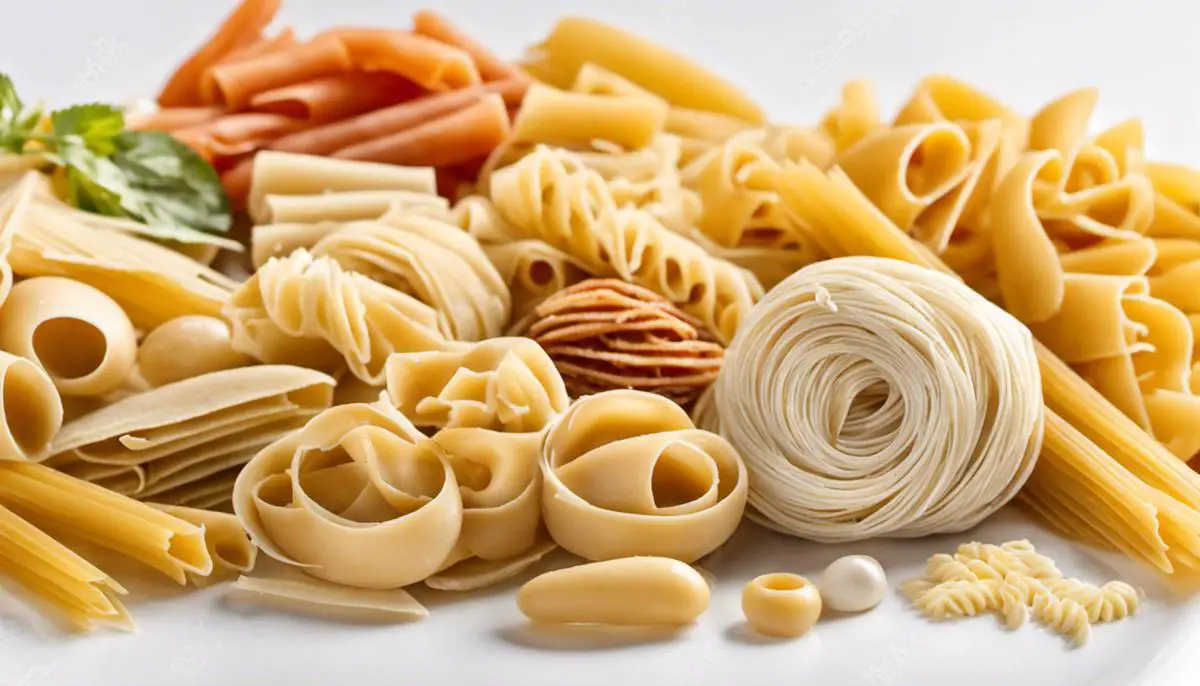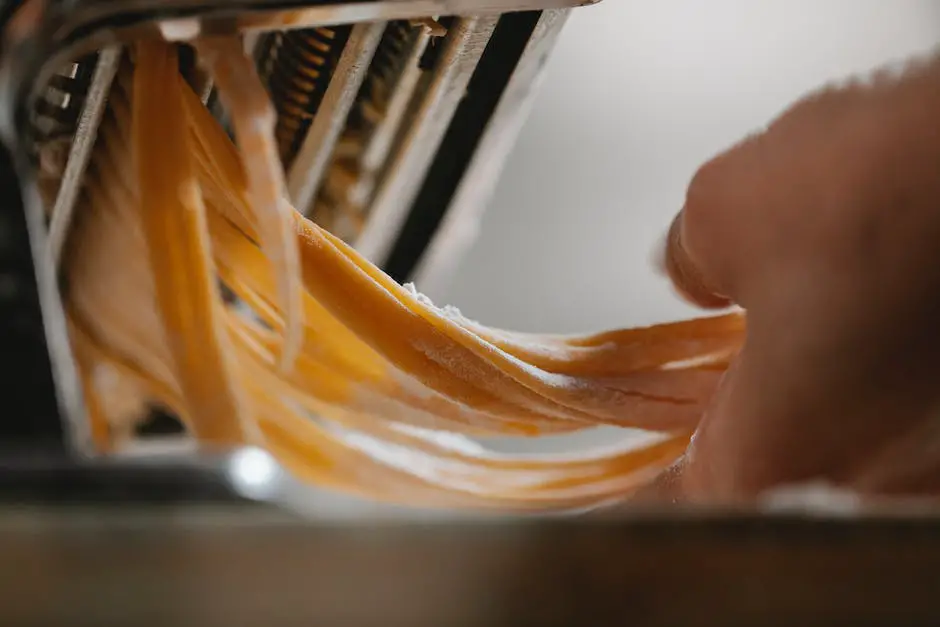Table of Contents
The universe of pasta is wonderfully diverse and infinitely delicious. This staple food of Italian cuisine has won the hearts of food lovers around the globe. Whether it’s spaghetti carbonara, fettucine alfredo, or farfalle with pesto, practically everyone has a favorite pasta dish. But have you ever thought about making your own pasta from scratch? While it might sound intimidating, homemade pasta is truly a testament to the beauty of simple, fresh ingredients and a craftsman’s touch. In this discussion, we delve into the basics of pasta making, guiding you through the types of pasta you can make, ingredients required, essential kitchen tools, and the whole process right from dough preparation to achieving that perfect ‘al dente’ bite.
Understanding the Basics
Understanding Different Types of Pasta
There is a vast assortment of pasta available, each with a unique shape, texture, and culinary purpose. Familiarize yourself with the different pasta types and their unique uses. For instance, spaghetti is renowned for its long, thin shape, perfectly suited for light olive oil-based or tomato-based sauces. Meanwhile, shorter and sturdier varieties, such as penne or rigatoni pasta, are designed to withstand robust, heavier sauces and multiple ingredients. Stuffed pasta, like ravioli and tortellini, pride themselves as meals within meals, containing various fillings such as cheese, meat, or vegetables. Then there are tiny shapes like Orzo, ideal for soups and salads. Learning about these can assist you in making substitutes in recipes or inspire your own pasta creations.
Basic Ingredients and Their Purpose In Pasta Making
At its core, pasta is made from simple, basic ingredients: flour and eggs. Despite their simplicity, these components play critical roles in the formation, texture, and flavor of your finished pasta.
Flour, the foundational element of pasta, serves as the structure-building component. Regular all-purpose flour can be used for pasta, but many prefer semolina; a specific type of high-protein flour derived from durum wheat. Semolina imparts a distinctive yellow tinge and yields a firmer, more robust pasta perfect for hearty sauces.
The egg, on the other hand, is what binds the flour together to form the dough. The liquid from the eggs hydrates the starch in the flour to form the gluten, which gives pasta its distinct chewy texture. Recipes sometimes call for just the egg yolks, contributing to a richer taste and a stunningly golden pasta.
Crucial Kitchen Tools for Pasta Making
When it comes to making pasta, a few essential tools can make your experience more streamlined. Whether you are shaping your pasta by hand or using a machine, ensure your kitchen is equipped with the following:
- A large mixing bowl is necessary for combining your ingredients. You may also need a fork or your hands to stir and then knead the mixture into a dough.
- A kitchen scale can ensure more accurate measurements, especially when working with simple recipes with just flour and eggs.
- A rolling pin is a must-have for stretching out your dough – crucial for many kinds of pasta. If you are making lots of pasta or want more uniformly thin pasta, a pasta machine can be an excellent investment. The machine allows you to roll out your dough to your desired thinness and also cut it into strips for noodles.
- Lastly, a pasta drying rack can be helpful. Although not necessary, it prevents pasta from sticking together as it dries and makes it easier to store your pasta if you make extra.

Pasta Dough Preparation
Selecting Your Ingredients
The foundation of any good pasta dough begins with choosing the right ingredients. The basic pasta dough calls for only two ingredients – flour and eggs. The general ratio to keep in mind is 100 grams of flour to 1 large egg. For a medium-sized batch of dough, you may choose to use around 300 grams of flour and 3 large eggs.
Kneading the Dough
After measuring your ingredients, the next step is to combine them. Put the flour on a flat, clean surface and create a well in the middle. Crack your eggs into this well. Using your hands or a fork, slowly draw the flour into the eggs, mixing as you go. Continue this process until a majority of the flour has been incorporated and you can form a rough dough ball.
Once you have a workable dough, you need to start kneading. This is where a bit of elbow grease comes in. Knead the dough by pushing it down and away from you, then folding it back on itself and turning it about 90 degrees. Repeat this process for about 10-15 minutes, or until the dough becomes smooth and elastic.
Resting the Dough
After kneading, it’s important to let the dough rest. Wrap it in plastic wrap, ensuring it’s well sealed, and leave it at room temperature. This resting period allows the gluten in the flour to relax, resulting in a dough that’s easier to roll and shape later on.
The dough should rest for at least 30 minutes but can be left for up to three hours. If you aren’t going to use the dough within three hours, it can be refrigerated for up to 24 hours. Be sure to remove it from the fridge and let it come back to room temperature before rolling.
Preparing for Pasta Making
Now that your dough has rested, you’re ready for the next step – turning that dough into pasta shapes. Before you start shaping and cutting, however, you’ll want to lightly flour your work surface. This prevents the pasta from sticking as you shape it.
Remember, the thickness of your pasta strands and the shape you decide to make will affect the cooking time of the pasta, so keep that in mind as you move onto the next stages. Knowing the process of pasta dough preparation, you’re now able to make a variety of homemade pasta dishes. Enjoy the process and, of course, the final product.

Shaping and Cooking Pasta
Rolling Out Your Dough
Start by sprinkling additional flour on your working surface and make sure your rolling pin is also floured to prevent the dough from sticking. Unwrap your rested dough, place it on the floured surface, and start rolling. Apply even pressure and roll from the center of the dough outwards.
Rotate the dough after each couple of passes with the rolling pin to ensure an even thickness and a roughly oval or rectangular shape. Rolling thickness will vary based on cooking preferences and the type of pasta shape being made.
Cutting or Shaping Your Pasta
Once your dough has been rolled out to your desired thickness, select your pasta shape. To shape the pasta manually, you can use a pasta wheel, knife, or pizza cutter. For long pasta types like spaghetti or tagliatelle, roll your pasta dough into loose cigar shapes, then slice width-wise to your desired thickness. Uncoil the cut dough into long, thin strands.
For stuffed forms like tortellini or ravioli, you’ll want to cut your pasta into squares. Place a dollop of filling in the center of each square, fold it over into a triangle or other preferred shape, and seal the edges with a fork or your fingers.
Cooking Your Pasta
Different pasta shapes and sizes require different cooking times. Thinner pastas, such as linguine and spaghetti, cook quickly — usually in two to three minutes. Thicker pasta shapes, such as fettuccine, take a bit longer — around three to five minutes. And stuffed pasta, like ravioli, usually take the longest — five to seven minutes.
When cooking, it’s important to use a large pot filled with plenty of water. Bring the water to a rapid boil, add a hefty pinch of salt, and then add your pasta. Reduce heat to medium-high where the water maintains a strong simmer and stir occasionally to prevent pasta from sticking together.
Achieving the Perfect ‘Al Dente’ Texture
Cooking your pasta to “al dente” — which means “to the tooth” in Italian — ensures the pasta is cooked, but still has a bit of firmness when bitten. This not only improves the texture but also helps the pasta to better hold sauces and ingredients.
To test for “al dente,” remove a piece of pasta from the pot midway through the estimated cooking time. Let it cool for a moment, then bite into it. There should be a tiny speck of white (uncooked pasta) at the center.
If the pasta is still too firm for your liking, keep testing every 30–60 seconds until the pasta is cooked to your preference. Once cooked, strain the pasta immediately to stop the cooking process and serve by adding your preferred sauce or ingredients.

From fettucine to farfalle, ravioli to rotini, each pasta has its charm and specific uses in the kitchen. All it takes to create these forms is the right technique and the love for all things pasta. Of course, the initial dough preparation and learning how to mix the right proportions of flour to eggs is crucial. The magic happens when this plain mixture transforms, through kneading and resting, into a top-quality pasta dough. This then becomes the canvas for your creativity when it comes to shaping, cooking, and finally, enjoying your own homemade pasta. With practice and understanding, you’ll be a pro at crafting ‘al dente’ pasta of any shape in your kitchen, taking your pasta dishes to the next level.

